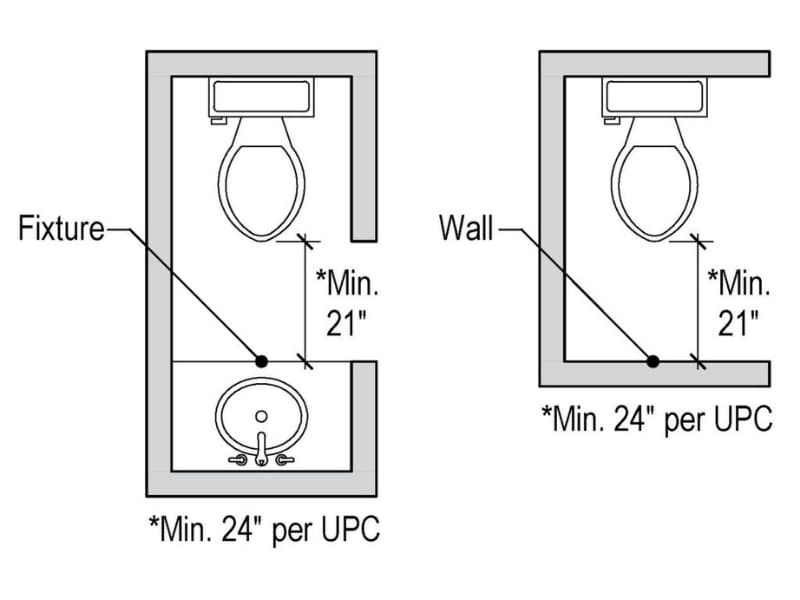The toilet is among the most essential fixtures in your house that should provide a comfortable experience. But, can you think of a wrongly-placed toilet that will force you to struggle when performing your business? It’s an annoying and disturbing experience. Therefore, perfect toilet placement is of great importance in your home.
Your toilet needs 15 inches of clearance from nearby objects. The water closet flange center should be 12 inches from the back wall. The space in front of the bowl must be at least 21 inches (UPC-24 inches). The cold water supply line should be 6 inches to the left or right of the toilet.
Securing an excellent bathroom design ensures that users acquire comfort and adhere to the applicable rules and regulations. Proper toilet placement using the correct measurements ensures that available space is well utilized. Here is an overview of everything you need to know for a perfect toilet placement. Keep reading!

Toilet Placement Dimensions
Your toilet requires a suitable placement on all ends. Thus, it would help if you considered the following measurements for a proper toilet placement:
1. Distance of the Toilet Flange to the Back Wall
First, you should secure a measuring tape for increased accuracy. The water closet flange center should be about 12 inches from the back wall. When measuring this distance, ensure you measure from a finished wall, not a base molding.
You should also consider your back wall’s thickness. If you applied 0.5-inch drywall, add an additional 0.5-inch to your measurement. Therefore, your new distance will be 12.5 inches. In case your drywall has an extra thickness, add some distance accordingly.
Other materials, such as mortar and mosaic tile, vary the drywall’s thickness. For instance, a mosaic tile has a 0.4-inch thickness, while a mortar has a 0.125-inch thickness. It is essential you understand these calculations correctly for accurate toilet rough-in dimensions.
The above-listed measurements are for your typical toilet that features a 12-inch round-in. You can confirm from the manufacturer’s manual if you’re unfamiliar with whether your toilet has a 12-inch round-in.
Although this measurement is standard, some toilets have 10- and 14-inch rough-ins. Therefore, you must know your toilet’s round-in before determining the distance between the back wall and the flange.
2. Space in Front of the Bowl
The space between the front of your toilet bowl and any wall or fixture varies depending on your local plumbing requirements. The International Plumbing Code (IPC) has highlighted some laws. Typically, this space measures a minimum of 21 inches.
However, the Uniform Plumbing Code (UPC) requires a 24-inch minimum clearance. For increased accuracy when measuring this distance, you’ll need to measure it from the front edge of the toilet bowl to the fixture or wall ahead of it.
3. Clearance from Left to Right
It would not be ideal with your toilet close to the walls so its users can lean on the sidewalls or take naps when using the toilet. It would be best if you allowed a clearance of at least 15 inches on the right and left. If your bathroom has ample space, you can increase this clearance as much as possible.
Note that the 15-inch clearance is for a finished wall. If you install the toilet before finishing the wall works, remember to add the thickness space. For instance, if you increase your sidewall thickness by 1 inch, you should leave a sideways clearance of 16 inches.
4. Placement of the Cold Water Supply Line
First, measure 6 inches on the left of your toilet. Then, measure 7 inches from the finished floor up the wall. Ensure your measurements are accurate. This can cause a serious and costly mistake. For safety, you can increase this height as much as you can.
What Happens When You Get the Toilet Placement Wrong?
Getting inaccurate toilet placement can lead to severe problems. Here are the most common issues you’ll likely experience after using the wrong round-in dimensions:
1. Unsuitable Toilet Size for the Space
Leaving inappropriate toilet placement for your toilet can leave insufficient space for your toilet sitting. This can leave your bathroom empty or force you to destroy the wall to create the necessary space.
2. Uncomfortable Seating
A wrong toilet placement can cause discomfort to its users. Imagine sitting on a toilet, leaning on the walls, and your legs close to the front fixture or wall. It can be such a tiring and uncomfortable experience.
3. Possible Plumbing Issues
Incorrect placement between the toilet and the cold water supply line can develop different plumbing issues. These may include the formation of clogs, low water pressure, low toilet flush power, and the breakage of pipes.
4. Non-compliance with Local Plumbing Requirements
As stated earlier, each jurisdiction has a code of governance that plumbers should follow. For instance, the Uniform Plumbing Code (UPC) requires that all toilets have a front clearance of at least 24 inches. Thus, non-compliance with such requirements can cause disciplinary action, especially for public toilets.
5. Leaking Flange
Wrong toilet placement can lead to a leaking flange. This is because the connecting pipes will have inadequate space for a durable connection. Weak connections will quickly wear out with time, leaving your toilet flange leaking.
A leaking flange is a major hazard to the house since it’ll destroy the subfloor and the whole floor. This can lead to costly repairs since the cost of installing tiles isn’t that low.
Small Bathroom Toilet Placement
You should not have excuses for wrong toilet placement due to a small-sized bathroom. If you have a small bathroom, you should consider and evaluate the following:
1. Fixtures
With a small bathroom, you should consider installing only basic fixtures. For instance, you can install grab bars, tissue holders, and a sink (at the right sink height from the floor). These less-space-consuming fixtures will leave enough space around your toilet bowl to acquire better clearance and enhanced comfort. Additionally, your bathroom will appear spaced and organized.
2. Space
Space is an essential aspect. How much clearance should you allow to comply with the applicable plumbing codes? Typically, your small bathroom should have a clearance of 12 inches from the back wall, 15 inches between the front of the bowl and fixture, and 15 inches from the left and right.
3. Free Door Movement
For your small bathroom, ensure that the door smoothly opens and closes. To achieve this, measure the door length from its hinges and allow circular space towards the wall and the front of the toilet. You should ensure that the door is at least 5 inches away from the toilet bowl when open.
Alternatively, you can set the toilet door to open outwards by altering the frame and hinges to prevent it from using the inner space. This space will provide a comfortable experience to all users, even with your small-spaced bathroom.
4. Toilet Rough-In
Typically, a standard toilet should have a 12-inch rough-in. This standard measurement allows ease of interchanging an old toilet with a new one. However, if you have an existing 10-inch round-in, you can alter the position of your toilet’s waste pipe to provide additional space. But, it would be best if you were careful not to minimize the distance between the water tank and the toilet.
Other aspects to consider are the small bathroom window and how it relates to the privacy of the bathroom.
Summary
Appropriate toilet placement is an essential feature of every toilet. It gives a comfortable experience to all toilet users. Further, it ensures compliance with the applicable plumbing codes in your jurisdiction. Fortunately, you can quickly achieve the correct toilet placement by measuring the proper clearance, rough-in, distance between the toilet flange and back wall, and proper placement of the water line supply in the toilet. These practical guidelines will work even for your small bathroom. Go and secure the correct toilet placement now!
